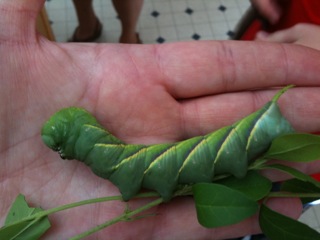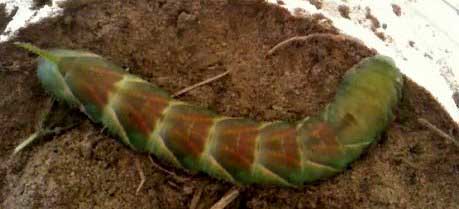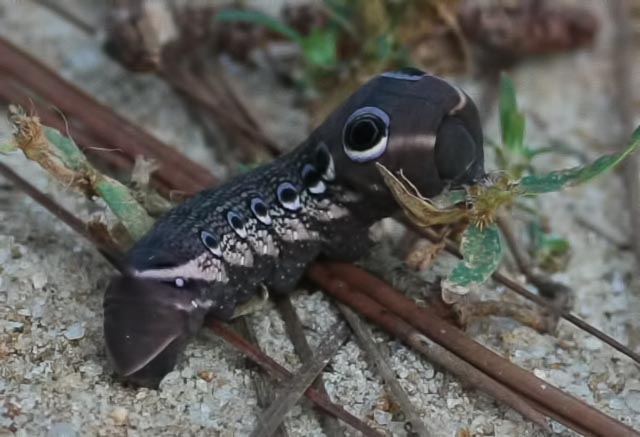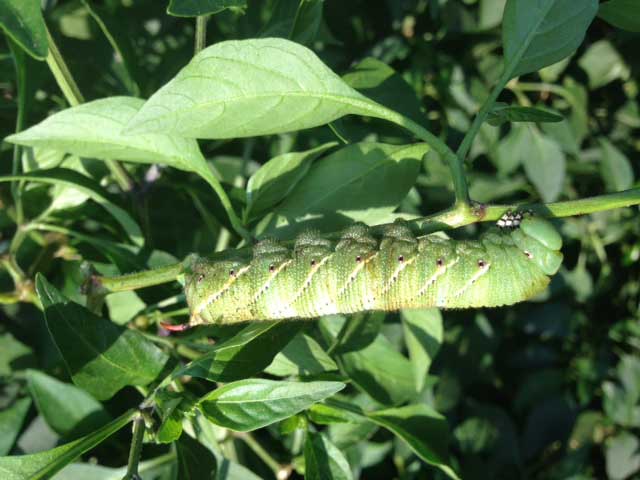
Manduca rustica, Raeford, Hoke County, North Carolina,
August 24, 2010, courtesy of Rebecca Biddle.
|
|
Created/dedicated as per personal communication with Rebecca Biddle, August 24, 2010 Updated as per James P. Tuttle's The Hawk Moths of North America, August 26, 2010 Updated as per Butterflies and Moths of North America, formerly USGS, August 26, 2010 Updated as per personal communication with Lisa Edwards, August 31, 2013 |

Manduca rustica, Raeford, Hoke County, North Carolina,
August 24, 2010, courtesy of Rebecca Biddle.
This page is inspired by and dedicated to Rebecca Biddle who sent me the image of a Manduca rustica caterpillar in Raeford, Hoke County,
August 26, 2010.
Rebecca writes, "August 29, 2010: when we checked on the caterpillar this morning (affectionately named "Steve"), he was lying on his side on the bottom of
his container. His body had darkened along his back, becoming a reddish brown color.
When we prodded him, he became active and started frantically crawling all around the bottom of his container, lifting the edges of the paper towels and
crawling under them. After a few hours, I took pity on him and put him in a large jar with about 6 inches of soil from the yard in the bottom of it.
Within seconds, he began rooting around in the soil and dug himself right into it! Within about 15 minutes, he was completely buried. So I put the lid
on tight and just left him there. There has been some condensation on the sides of the jar, but I'm concerned about the moisture level being right.
I want our little guy to have conditions that are right for him. What should I know and do now?"

Manduca rustica prepupal fifth instar, Raeford, Hoke County, North Carolina,
August 29, 2010, courtesy of Rebecca Biddle.
"I have read what I consider to be very reliable reports that Sphingidae pupae often wiggle to the surface of the ground when the moths are ready to emerge. They travel upwards through the same tunnels that they excavated as caterpillars.
"You could put a stick on a slant in the jar so that if the moth does emerge in the next few weeks, it will have something to climb on and hang from to inflate its wings. If it does not emerge within the next few weeks, you are faced with the dilemma of how to store that large jar. I don't imagine the refrigerator is an option.
"Outdoor storage could be hazardous as the jar might collect water and the pupa might drown. Perhaps it would be okay out of the house in an unheated garage or shed, sheltered from rain and snow.
"If I were in your situation, I would wait another few days just to make sure the caterpillar has pupated, and the pupal shell has hardened. Then I would carefully unearth the pupa and store it as recommended in the article below, entitled "care of "found larvae/caterpillars"". Life is an adventure. I often experiment with things that seem to make sense to me. Sometimes they work, sometimes they don't, but I always learn something. Please let us know how you make out. Best of luck."
Rebecca also sends the following image of a Xylophanes tersa larva.

Xylophanes tersa fifth instar, Raeford, Hoke County, North Carolina,
October 16, 2008, courtesy of Rebecca Biddle.
Thirty-six Sphingidae species are listed for North Carolina on the U.S.G.S. website. Not all of the species are reported or anticipated in Hoke County (None are reported on U.S.G.S. as of August 26, 2010). It is hoped that this checklist, with the thumbnails and notes, will help you quickly identify the caterpillars (larvae) you are likely to encounter.
A "WO" after the species name indicates that I have no confirmed reports of this species in Hoke County, but I (William Oehlke) expect that this moth is present or might be present.
A "USGS" indicates the moth is reported on the USGS website (now BAMONA and/or in Lepidoptera of North America, #1. Distribution of Silkmoths (Saturniidae) and Hawkmoths (Sphingidae) of Eastern North America, an excellent little booklet available through Paul Opler.
Please help me develop this list with improved, documented accuracy by sending sightings (species, date, location), preferably with an electronic image, via email to Bill Oehlke.
Many thanks to Lisa Edwards who sends the following image of a Manduca sexta larva.

Manduca sexta on red peppers, Raeford, Hoke County, North Carolina,
August 31, 2013, courtesy of Lisa Edwards.
Sphinginae subfamily
Smerinthini Tribe:
Macroglossinae subfamilyDilophonotini tribe:
See Hemaris comparison to help distinguish the next three species.
Philampelini tribe:
Macroglossini tribe:
|
Enjoy some of nature's wonderments, giant silk moth cocoons. These cocoons are for sale winter and fall. Beautiful Saturniidae moths will emerge the following spring and summer. Read Actias luna rearing article. Additional online help available.
Eggs of many North American species are offered during the spring and summer. Occasionally summer Actias luna and summer Antheraea polyphemus cocoons are available. Shipping to US destinations is done from with in the US.
Use your browser "Back" button to return to the previous page.
This page is brought to you by Bill Oehlke and the WLSS. Pages are on space rented from Bizland. If you would like to become a "Patron of the Sphingidae Site", contact Bill.
Please send sightings/images to Bill. I will do my best to respond to requests for identification help.
 Show appreciation for this site by clicking on flashing butterfly to the left. The link will take you to a page with links to many insect sites. |
I very much appreciate all the many images that have been sent to me, or of which I have been granted permission to copy and post from other websites. All images on this site remain the property of respective photographers.
If you would like to contribute to the maintenace of this website by sending a contribution to
Bill Oehlke
Box 476
155 Peardon Road
Montague, Prince Edward Island, C0A1R0
Canada
your donation would be much appreciated and would be used for
1) paying for webspace rental;
2) paying for computer maintenance and software upgrades;
3) purchases of additional text reference material (journals and books) in anticipation of expanding the site to a worldwide Sphingidae site;
4) helping to pay my daughter's tuition (completed spring of 2013); with anything left over going to humanitarian aid.
If you are mailing a check from USA, please use $1.10 postage (2013 rate). Donations can also be made through Paypal via the button below.